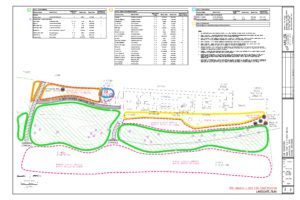 Project Update (11/1/17): A crew from Milaeger’s completed the landscaping portion of the green infrastructure project last week at the lighthouse grounds. They installed dune grasses and native plantings that will make up the butterfly garden area along the south lawn. Visitors are asked not to walk over areas with new plantings.
Project Update (11/1/17): A crew from Milaeger’s completed the landscaping portion of the green infrastructure project last week at the lighthouse grounds. They installed dune grasses and native plantings that will make up the butterfly garden area along the south lawn. Visitors are asked not to walk over areas with new plantings.
The beach area improvements were recommended in the Beach Water Quality Report 2010-2012 produced by the Racine Health Department. The report identified opportunities to improve stormwater quality near the beach, enhance aesthetics and increase public access. Dr. Julie Kinzelman, Adrian Koski, Joel Brunner and Sarah Wright from the City of Racine Health Department Laboratory were instrumental in producing the water quality report and providing information necessary for the grant. The green infrastructure improvements help advance one of the Village’s overarching priorities which is to protect and enhance our natural assets.
Background
Prior to 2010, Wind Point Lighthouse Beach was not monitored for water quality. A Great Lakes Restoration Initiative (GLRI, 2010 ‐ 2012) grant provided initial funding for beach sanitary surveys in order to gauge recreational water quality and determine potential sources of fecal pollution. As a result of the study, it was determined that half of water samples exceeding recreational water quality standards (>235 CFU/100ml E. coli) were associated with precipitation events. Stormwater runoff from the adjacent parking lot and turf grass lawn was visible during and following precipitation. Reducing stormwater runoff through green infrastructure improvements was recommended to maintain recreational water quality.
A subsequent GLRI grant (2011 ‐ 2012) funded a conceptual redesign plan and list of best management practices for the beach with the goals of: 1) proactively improving water quality and beach health, 2) enhancing public access and 3) promoting current site uses (i.e. tourism, swimming and birdwatching). Approved by the Village, the concept plans were turned into a full set of engineering plans. The redesign plan elements complement existing onsite green infrastructure, such as the permeable pavement in the overflow parking lot, and are not required for any permits or enforcement orders. They use green infrastructure, bio‐infiltration and permeable walking surfaces, to reduce stormwater runoff and promote site access, thus addressing identified sources of fecal pollution and achieving project goals.
Project Elements
Design plan elements were sited in locations that maximize project goals without interfering with existing onsite amenities. The topography of the beach and surrounding environment was evaluated to determine drainage patterns. Sand dunes and the butterfly/hummingbird garden were placed south of the memorial brick garden in areas that would most effectively capture runoff. Beach nourishment will occur at key locations in order to reduce the extent of waves from encroaching onshore. Enhanced public access points will connect to existing pathways in order to save costs and promote site accessibility. All naturalized bio‐infiltration features and built structures will be placed above the ordinary high water mark to reduce the likelihood of damage from storm events.
Stormwater Infiltration. Stormwater runoff will be captured and infiltrated in a bio‐infiltration feature adjacent to the sand dunes and butterfly/humming‐bird garden. The deep root structure of native vegetation associated with the dunes and butterfly/humming‐bird garden will help stormwater infiltrate into the ground. Additionally, the vegetation will increase transpiration and uptake nutrients. These features are estimated to capture runoff from approximately 5 ½ acres of turf grass and impervious surface and prevent approximately 195,000 gallons of untreated stormwater and associated pollutants (bacteria, nutrients, suspended solids, etc.) from entering Lake Michigan annually. In addition to aiding in pollutant removal, vegetation will disrupt lines of site between the beach and lawn which will in turn discourage nuisance wildlife such as geese and gulls. Ultimately, this will reduce the direct and indirect transfer of feces to coastal waters resulting in improved coastal water quality.
Native Vegetation. In addition to water quality benefits, native vegetation within the dunes and pollinator garden will enhance existing site aesthetics, restore coastal habitat and increase sustainability. Examples of vegetation included within the redesign plan include Marram Grass, Little Bluestem, Switchgrass, Butterfly Milkweed, Coneflowers, Goldenrod and more. Native vegetation reduces soil erosion and provides ecological benefits for migratory birds by providing a food source and nesting materials. Restoring coastal habitat in a migratory bird flyway will provide additional tourism opportunities. Native vegetation is also desirable from a sustainability perspective. Once plants are established, maintenance is anticipated to be minimal due to their adaptation to the local climate and resistance to pests and diseases.
Beach Nourishment. Beach nourishment will reduce wave run‐up and increase stormwater infiltration. Reducing wave run‐up, a mechanism which transfers bacteria from sediments to water, will improve coastal water quality. Additional sand will also raise the beach above the water table and reduce ponding. Dry conditions result in a reduction of bacteria concentrations in sediments, leading to less being available for subsequent transport to the nearshore waters. Beach nourishment will be accomplished through the import of clean upland sand (torpedo sand). Slightly coarser than the existing sand, it will promote infiltration, reduce loss due to wind erosion, and diminish capillary rise (a process by which sands remain permanently wetted, promoting bacterial persistence).
Public Access. Other features in the project will enhance public access. A limestone and cord‐walk path will be placed at the end of the existing sidewalk to increase access to the beach. In addition to improving access, the paths will help protect vegetation from being trampled and ensure sustainable access to the lake. The cord‐walk path is permeable and will not generate additional surface runoff.
Look for updates on the beach green infrastructure project in the Wind Point E-News and on this webpage.
